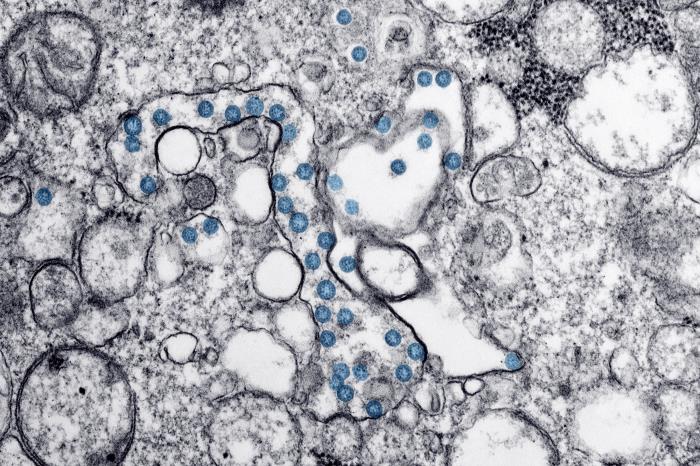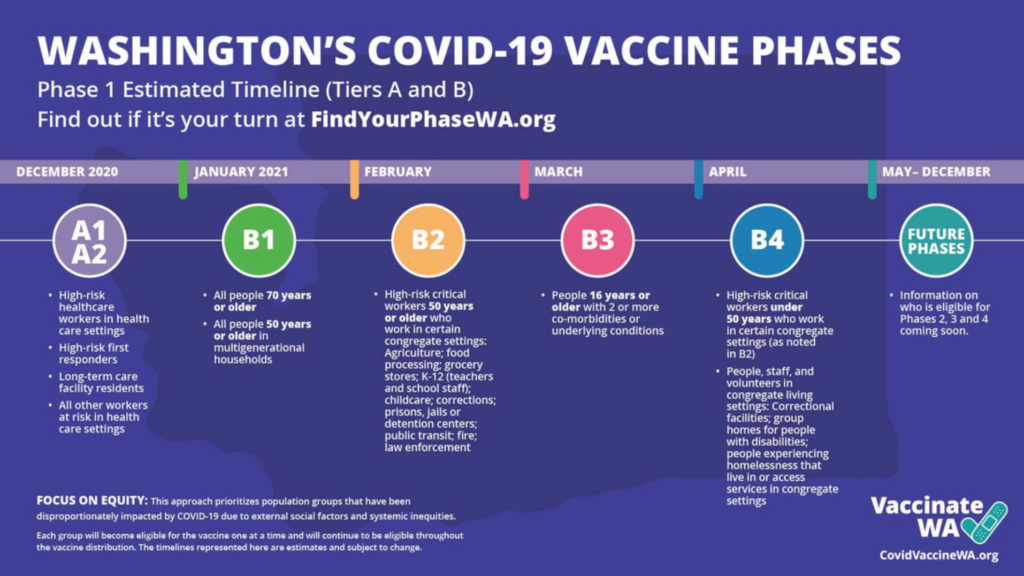After administering the first local COVID-19 vaccinations in December, Whitman County health officials expect the federal supply chain and the state prioritization plan to determine broader vaccine availability in the coming months.
More than 1,050 people working in health care or living in long-term care facilities in Whitman County have already received their first of two Pfizer vaccine doses, officials reported Friday. They hope to vaccinate another 500 or so people in the coming week.
Ben Stone, public information officer for Whitman County Public Health, said local health care workers and other community partners have worked hard to get vaccines to the people who need them most in recent weeks.
“I’ve been really inspired,” he said. “The community in Whitman County has really pulled together.”
State officials this week released new guidelines for how vaccinations will be prioritized, outlining the initial steps for protecting the highest risk residents. The entire state remains in the 1A phase, which provides vaccines to front-line health care workers and nursing home residents.
Upcoming phases will include first responders (some of whom have already been vaccinated locally), people over 70 years of age, people with high-risk underlying conditions and essential workers in food supply chains and education. The state should move into the next phase later this month. Additional phases are still being defined and will be announced later.
Local officials initially predicted 1,600 people in the county would qualify for the 1A phase. Stone said they have identified additional people who qualify as they have started vaccinations, while some who qualify have declined vaccination.
He estimated about 60 percent of eligible health care or high-risk employees have opted to take the vaccine. He said a higher rate of nursing home residents or long-term care workers had sought vaccinations.
“We’ve had a lot more buy in from those in long-term care facilities,” he said.
Stone said reports of adverse side effects were minimal with the primary complaint being some soreness of the arm around the injection. The Moscow-Pullman Daily News recently reported on the efforts to vaccinate local nursing home residents and staff. Read that reporting here.
The county has so far received two 975-dose shipments of the first “primer” vaccines from Pfizer, Stone said. They have also received two corresponding shipments of Pfizer’s “booster” doses for the second-round shots, which are given after three weeks. Officials hope to get a third shipment of primer doses in soon.
While the state has approved the Moderna vaccine, Stone said the county has yet to receive any shipments.
Whitman County health officials stated vaccination distribution information will be reported at least weekly moving forward. The state offers its vaccine guidelines and updates here. The New York Times has a national vaccination tracker here, showing the rates of immunizations by state.
HOW WILL I KNOW WHEN I AM ELIGIBLE?
With the limited number of doses available so far, Stone said health officials have done direct outreach to the workers and residents who qualify for the first phase of vaccinations. Health care officials have organized some targeted vaccination drives to inoculate nursing homes, hospital staff and others with the highest risk.
State officials would like to move the entire state through the phases together, so they will direct vaccine shipments to the counties that have the highest outstanding need for 1A vaccinations until they catch up, Stone said. Then the whole state can progress to the next phase and offer expanded eligibility.
“A lot of those phases aren’t finalized yet,” he said, noting those definitions should be announced in the coming weeks.
The state Department of Health has launched a Phase Finder tool that includes a survey about a person’s risk factors, age and county of residency. Stone said this tool will be one of the primary methods for notifying people when they are eligible. Right now, the tool only indicates whether a person qualifies for 1A, but it will be expanded to give additional details later this month.
Even if you do not currently qualify, the Phase Finder also asks for a phone number or email address, so it can notify you later when you become eligible.
“That’s going to be a really important thing to do,” Stone said.
In addition to Phase Finder, local officials plan to put out regular news releases on vaccine phases and distribution. They will also coordinate with relevant employers, such as school districts or grocery stores, when their workers become eligible.
(The Equal Employment Opportunity Commission ruled last month that employers can require workers to receive the COVID-19 vaccine, with some exceptions.)
For those wondering what documentation they may receive to prove they have been vaccinated: Stone said the CDC provides a standardized vaccination card that verifies the vaccination and also establishes the return dates for the booster dose.
While officials have prioritized Whitman County residents for vaccine distribution, Stone noted that is not a “hard line.” If someone from Moscow or Spokane works in a high-risk field in Whitman County, local officials consider it a priority to get them vaccinated.
The state’s prioritization plan is based on risk-factor guidance from the federal level. The first large-scale expansion is currently expected with the B2 phase in February, which will open eligibility to essential workers of at least 50 years of age in agriculture, food processing, K-12 education and other key industries.
VACCINE SUPPLY CHAIN ISSUES
State officials announced they have so far received more than 500,000 doses from the federal government. More than 150,000* had been administered by earlier this week with data indicating the pace of distribution is starting to speed up.
Stone said the county currently gets a week’s notice or less of any incoming shipment of vaccines. That can make it difficult to schedule larger drives or notify people of new availability. The predictability of new shipments has been one of the biggest challenges of the initial rollout.
“The supply chain right now is … unstable,” he said. “It’s a very quick turnaround timeline.”
As the pipeline stabilizes, officials plan to work toward mass vaccination drives along with increasing distribution to smaller providers throughout the county. Stone said they are working closely with the state Department of Health to troubleshoot distribution challenges and clarify long-term plans.
“The Department of Health has done an amazing job given the circumstances,” he said, comparing the effort to the moon landing. “It’s just a massive undertaking.”
UPDATE, Jan. 10: The Seattle Times today published an in-depth look at problems and delays in the state’s initial vaccine rollout. Read that story here.
Local officials reported they are also working closely with community partners such as Pullman Regional Hospital, Palouse Medical, Whitman Hospital & Medical Center, Schweitzer Engineering and WSU. The university put out new information this week on the vaccination of its health care workers.
NEW STATE REOPENING PHASES ANNOUNCED
Gov. Jay Inslee and state health officials announced new business reopening guidelines earlier this week, which restarted all counties at a newly established Phase 1 and grouped counties into eight broad regions. Find a breakdown of those new regions, phases and guidelines here.
Whitman County is grouped into an Eastern Region with Spokane and seven other rural counties. The new Phase 1 starts Monday and includes some new capacity limitations for various activities. (It reverses the previous ban on live music and entertainment if the venue complies with all other guidelines.)
Moving forward to Phase 2 will require the region overall to meet several metrics for available health care capacity and reduced transmission rates:
- Decreasing two-week rates for cases per 100,000 residents
- Decreasing two-week trend for hospital admission rates per 100,000 residents
- Maintaining an ICU occupancy rate below 90 percent
- Maintaining a positivity rate of less than 10 percent over seven days
Interim Public Health Director Chris Skidmore recently expressed some concern about how grouping Whitman County with the larger Spokane area would impact the local re-opening schedule. Read coverage of his comments on Pullman Radio News here.
Stone said those rates will be measured according to the rates on the state DOH dashboard, which has sometimes varied widely from local measurements. Find more details of the reopening plan here.
In recent weeks, the state has also increasingly listed higher numbers of COVID-19 deaths than Whitman County officials have confirmed. The state now lists 33 COVID-19 deaths while local officials have announced just 23 deaths.
Stone could not completely explain the discrepancy. He said local officials report only those deaths confirmed by the county coroner while the state data is often based on automated inputs from across the state. Local officials have had ongoing discussion with state officials trying to reconcile those numbers.
Update, Jan. 11: Local officials announced today they would start using the state DOH data to count local deaths, saying the state information may better reflect hospitalizations and deaths outside the county.
With the increase in cases this winter, Stone noted many hospitals and ICUs have been “stressed and stretched,” leading to a significant increase in patient transfers to Spokane, the Seattle area or elsewhere. Every time a patient gets transferred, their data gets harder to track down and confirm locally.
The multiple points of contact for a single patient may impact those automated inputs, he said, and can complicate matching them up with local residents. Local officials maintain their death figures are likely the most accurate.
*Vaccine usage total updated Jan. 10 after finding newer numbers.

